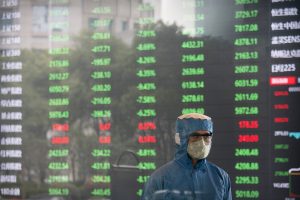Everyone knew China’s quarterly GDP data for Q1 2020 would post a contraction as the effects of the ongoing COVID-19 pandemic became apparent, but estimates differed of what exactly to expect. Now we know: Beijing’s latest official economic data, released Friday, shows that the country’s economy shrank by an eye-popping 6.8 percent in the first three months of the year compared to a year prior (the year-on-year measure, comparing growth in Q1 2019 to Q1 2020). The figures mark the first quarterly economic contraction in China since 1992, ending one of the greatest streaks of quarterly continuous growth in modern history.
That’s higher than most estimates, which had put the expected contraction at around 6.1 percent. Seasonally adjusted quarter-on-quarter figures, which are a less useful point of comparison, also merit mention. Chinese GDP here declined 9.8 percent, or 34 percent annualized. Already, watchers of the Chinese economy have expressed concerns that this data may obscure a more dire situation to come, fearing that the officially sanctioned data — which is already negative — is still somewhat massaged.
Q1 2020 data from China was always going to mark an important bellwether for the global economy as the economic contagion from this pandemic went global, but it’s not clear to what extent investors had already priced in these numbers, which would have been unimaginable four months ago. In December 2019, for instance, any authoritative projection that China’s GDP in the first quarter would have contracted by more than 3 percentage points would have led to a massive panic.
Now, despite the Chinese GDP numbers turning out worse than expectations, investors appeared mostly unfazed. Asian markets closed in the green on Friday; as of this writing, U.S. blue chip companies with massive Chinese exposure also appeared to brush off the figures. What’s going on here? One explanation might be that investors are anticipating a “rubber-banding” effect on Chinese productivity into Q2 and later this year; as a result, firms with China exposure elsewhere might seem undervalued at the moment. Despite skepticism of official Chinese messaging on the COVID-19 situation internally, Beijing is projecting a return to some degree of economic normalcy.
That tells part of the story, though, and overly emphasizes the supply side. On the demand side, China’s March 2020 retail data paints a more concerning picture, with consumer demand for major goods (with the exception of food and beverages) down across the board—a common trend across all major economies that implemented lockdown measures amid the pandemic. Looking at the figures alone and the Chinese economic policy response to date, it’s unclear that policymakers in Beijing will have the tools available to quickly restore consumer demand, which could significantly dampen any optimistic “rubber-banding” effect on overall manufacturing productivity.
It’s still too soon to chart what comes next for China, but what might be most remarkable about the historic Q1 2020 GDP numbers is how they’ve barely registered with equity markets. Where once a 6.8 percent quarterly drop in Chinese GDP might have seemed like the start of a global economic crisis, today it is but a symptom — a mostly expected one — of the pandemic.
This article is presented by Diplomat Risk Intelligence, The Diplomat’s consulting and analysis division. To learn more about DRI, click here.

































